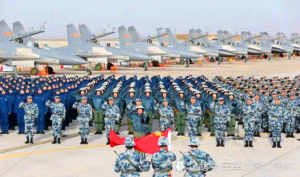By Aron Mehta, Defense News–
The recent National Defense Strategy identified great power competitors as the major challenge facing the Pentagon, but Gen. Paul Selva, vice chairman of the Joint Chiefs of Staff, noted that the plans required to counter each nation are naturally “in tension with one another” for resources.
“Here’s why they will be in competition with each other: They are not the same,” Selva explained during an event hosted by the Defense Writers Group. “There are two unique competitions that we have to deal with, and the elements are overlapping but not the same.”
“Any fight with China, if it were to come to blows, would be a largely maritime and air fight,” Selva said. “It doesn’t mean the Army and the Marine Corps don’t have a place. But when you think about how a potential conflict with China would evolve, it very likely involves a substantial contribution from the naval and air forces, and the Army and Marine Corps would be supporting elements in that fight.”
In contrast, “the Russia global problem set is largely an air and ground fight. Supported by elements of our maritime component, because you can’t get to Russia, you can’t get to Europe in any large measure without transiting the North Atlantic,” he said. “Which means there’s going to be a maritime fight to get things to the continent, but the fight itself as it evolves is likely to be an air and ground fight.”
Of course, there are other threats to the U.S. besides Russia and China. In recent strategy documents, the Pentagon narrowed its focus to what it calls the 4 + 1 threats — Russia, China, North Korea, Iran and terrorism.
North Korea is the easier to plan for, Selva noted, as Pyongyang “derives almost all of its military capabilities from buying hardware from either Russia or China,” which means planning for the two peer competitors covers the rogue nuclear state.
/arc-anglerfish-arc2-prod-mco.s3.amazonaws.com/public/46KLT4TM6NACXDKS6KOJWRMKY4.jpg)
Affordability
But figuring out which is the likeliest scenario and how to invest accordingly are major challenges being worked out inside the Pentagon. Selva indicated that those challenges will be part of the upcoming National Military Strategy, expected to be completed before the end of the year. But the question of having enough funding to prepare for both is clearly on Selva’s mind.
“If it’s not affordable, then we will express the risk to the secretary, to the president and to the American people,” he said. “Then we have to go to the secretary and president and say: ‘We are assuming risk on behalf of the American people because we can’t do this set of tasks.’ We can either appropriate the funds to get those tasks done, or we can articulate the risk.”
Andrew Hunter, an analyst with the Center for Strategic and International Studies, agrees that the Pentagon needs to think of China and Russia as separate threats. But he notes there are areas of common investment for both challenges.
“In both instances there is a premium on having access to instantaneous situational awareness and ability to find people on the battlefield, and be able to do the command and control to strike in very tight time frames,” Hunter said, adding that broad spectrum C4ISR — command, control, communications, computers, intelligence, surveillance and reconnaissance capabilities — is an area in which the Pentagon is routinely investing.
Hunter also warns not to expect the Chinese or Russians in a shooting war to play fair and try to match the Pentagon one on one.
“Are they going to try and do a straight up assault on the U.S. Air Force? My guess would be they probably won’t do that because that’s probably a losing proposition for them and they’re probably too smart of that,” Hunter said. “My guess is they will find a way to come at us that, at least, it won’t be something where our advantage is so overwhelming that it becomes a farce.”


Leave A Comment
You must be logged in to post a comment.